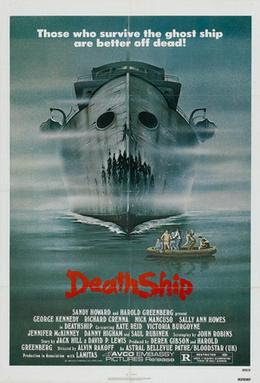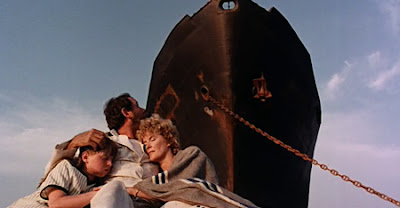(+JMJ+) Commentary on horror/ thriller movies you forgot about, wanted to forget about, or just haven't heard of...yet. Thousands of them (eventually). "Watch horror movies... Keep America strong!" - Bob Wilkins (Be sure to check out my other movie commentaries at 1000daysofscifi.blogspot.com and at dontfastforward.blogspot.com)
Thursday, December 31, 2020
75) Death Ship (1980)
Tuesday, November 24, 2020
74) House of the Devil (1896)
I don't know if French film maker, Georges Méliès, is considered the grandfather of movie special effects. If not, he ought to be. Being an illusionist who utilized many technical developments in the earliest days of cinema, such as splicing, multiple film exposures, time lapse, scene dissolves, and early forms of film colorization that involved painting film, Méliès is most certainly a founding father of storytelling in film. Plus, he's known for being one of the first film makers to use storyboards.
 |
| Mephistopheles summons a figure from a cauldron. |
Monday, November 16, 2020
73) The Canterville Ghost (1986)
 |
| Alyssa Milano and Sir John Gielgud. |
 |
| Sir John Gielgud as Simon de Canterville |
Friday, November 6, 2020
I Saw 'Em All: Tremors (1990 - 2020)
Other reviews coming soon...
Tuesday, October 20, 2020
72) Lake Mungo (2008)
Back in 2006, advertisements for the "After Dark Horrorfest" (an annual horror film festival which featured eight independent horror movies) started airing.
Tuesday, October 6, 2020
71) Alice, Sweet Alice (1976)
 |
| Paula Sheppard in Alice, Sweet Alice |
 |
| Alphonso DeNoble |
 |
| Brooke Shields in her debut role. |
Thursday, September 17, 2020
70) Horsehead (2014)
Generally, in horror, the last thing a character would want to do is fall asleep. Bedtime is guaranteed death in a horror movie.
Reality and dream state are distinct from each other, there's a lot taking place.
Sunday, September 13, 2020
Horror in Omaha
A recent extended weekend vacation to Omaha brought about a horrific night - dinner at "The Monster Club" at Omaha's Old Market area.
A cocktail (a Moscow Mule) and a smoked monster burger left me begging for my life.
The bloody, horrific, decaying decor killed more than my appetite. I'd go again in a heartbeat, or that of an artery.
It was a fun time! And they're not a sponsor.
Saturday, September 12, 2020
69) Family Possessions (2016)
I pulled this movie from the part of my horror library that increased slightly thanks to a subscription to horrorpack.com.
I recently published a post on this blog, along with a podcast on anchor.fm, regarding the large number of exorcism horror movies there are these days. I thought this movie would land in the heap of such movies.
Family Possessions is an independent supernatural horror. The word "possessions" is a bit deceptive, though. The cover art didn't help correct my assumptions.
 |
| Erika Edwards (left) and Leah Wiseman. |
 |
| Mark Patton in Family Possessions - his first role in 31 years. |
Tuesday, September 1, 2020
68) Billy the Kid vs. Dracula (1966)
Among my office space decor hangs a postcard pinned to my cubical divider. The image is of a vintage Mexican lobby card for a movie called Billy the Kid vs. Dracula. I bought this postcard ten years ago at a local used book store and hung on to it with the intention that someday, I would find that movie.
Though I'd never seen the movie until now, the title alone led me to an assumption it was among the schlockiest of horror movie titles I had ever heard of. I've wanted to see this ultimate showdown ever since I bought that postcard. The title is as appealing and enticing to me as Santa Claus Conquers the Martians. That's a real movie, by the way, which was released two years before this one. But unlike that title, Billy the Kid vs. Dracula doesn't give away the ending. This is from the mid-sixties - an era when the good guys always win in the movies.
The film starts as a fake bat (shhh...we're not supposed to know it's fake. Just pretend it's real) glides behind the opening credits.
We then witness Dracula (James Carradine) sneak into a campsite as a family is fast asleep. He seduces a young girl with a deathly, hypnotizing glare, and then bites her on the neck. Her mother wakes up to find her daughter lifeless with teeth marks on her neck. It's clear to her what has happened.
A stagecoach heading to Wickenburg, carrying some wealthy individuals, is on its way to a scheduled stop in the town of Papago Wells for an overnight stay.
On board is Mary Ann Bentley, her brother James Underhill, a Whiskey salesman named Joe Flake, and a mysterious passenger the others don't realize is Dracula himself. As the four riders chat during their trip, Mrs. Bentley starts talking about her daughter Betty Bentley.
She shows Dracula her picture, which unbeknownst to Mrs. Bentley, arouses his passion. He now has eyes for Betty and intends to find her. He doesn't say this to Mrs. Bentley of course, but the audience knows.
When they stop at their destination, Dracula spots an Indian girl named Nana who works for the stagecoach company along with other members of her tribe.
As night arrives, he transforms into a (rubber) bat and visits her. He then seduces the poor girl, leaving her dead. Those of her tribe find her body and blame her death on white people. They don't hesitate. Her tribe members chase the stagecoach after it departs the next morning and attack it, killing the Mrs. Bentley, James Underhill, and the Whiskey salesman. Dracula stays behind in Papago Wells.
Once news of the attack gets back into town, Dracula visits the destroyed stagecoach and steals Underhill's papers and the picture of Betty.
Meanwhile, Billy the Kid (Chuck Courtney - Pet Sematary 1989) has turned himself around and is no longer the outlaw he's well known to be.
He's not only a reformed man, Billy also happens to be working on the Bentley farm and is engaged to Betty.
He heads to town to await the stagecoach and pick up Betty's mother and Uncle, but is met by Dracula instead at the hotel the coach is scheduled to stop at. Dracula poses as Betty's uncle whom she has never seen before and news of the attack reaches Billy's ears.
 |
| James Carradine as Dracula. |
When Billy meets Dracula posing as James Underhill, Billy learns about the attack on the stagecoach and the death of the passengers. Dracula gives a claim of what went down. And while there's no reason for Billy and Betty not to believe him, others at the hotel believe the entire situation to be the work of a vampire. Billy doesn't believe that, of course.
Dracula returns with Billy to the Bentley farm.
One of the help at the Bentley farm, a woman named Eva (Virginia Christine), is convinced the man posing as James Underhill is a vampire. Billy, however, isn't convinced despite her insistence.
Dracula works to impose himself into the family, ultimately to seduce Betty and make her his bride. While this is playing out, a farmhand challenges Billy to a gunfight at the Bentley ranch.
Billy shoots the farmhand in self-defense, but is still forced to leave town after being arrested by the Sheriff. Meanwhile, Dracula takes authority upon himself as Betty's fake uncle and forces Billy never to return to the ranch again.
He gets one of the ranch hands to force Billy out, and even threatens Billy that if he returns the farm hand has permission to kill him. Dracula also fires Eva and her husband, so he can be alone with Betty.
Betty is forced to call off the engagement under the direction of her "Uncle." And the farm hand, under the instruction of Dracula, begins forcing Billy to leave town altogether.
But when Eva returns to the ranch, and finds Betty's neck bearing bite marks, she knows what's up. It was her daughter who fell victim to Dracula in the beginning of the movie. Her suspicions are confirmed, and she finally convinces Billy, who didn't believe in vampires before, to face off with Dracula once and for all.
As schlocky as the title may suggest, and as low budget the movie is with all its laughable special effects and rubber bats, it somehow manages to be somewhat engaging.
Carradine is able to create a character the audience loves to hate. His evil, callous, insatiable appetite, and lack of empathy are clear and despicable. In other words, he makes a decent Count Dracula.
This same year, Director William Beaudine directed a western horror movie Jesse James Meets Frankenstein's Daughter. Evidently, it was released the same day as Billy the Kid vs. Dracula. That's a fair amount of horror from the old west in one day.
But with a run time barely over an hour, the movie is a lot of buildup, albeit somewhat effective, for a quick resolution - the fight we were waiting for. It just fizzles out like a candle at the end of its life. It's just a shrivel, and a puff of smoke.
The audience does get a fight but I know I felt swindled. It could have been so much more. There was room for more, after all.
The movie didn't need to make Billy the Kid a redeemed man. I was expecting to see an iconic outlaw of the west face off the unholy, undead monster of Transylvania. That would have been much more epic and satisfying. Clearly, the producers were trying to give audiences a character they could cheer for without feeling guilty about it. This is not who Billy was. In a way, it defeats the purpose of the movie. It's like if Freddy Krueger turned over a new leaf and became a day care provider sometime right before 2003's Freddy vs. Jason. Why bother paying the price of the ticket?
Billy was a gunfighter who killed eight men at age 21. He was a fugitive. An outlaw. Why change him because he's up against Dracula?
Despite its obscurity, Billy the Kid vs. Dracula has potential to be a fun reboot as this movie could use stronger writing. For something this creative, it deserves a better treatment. Billy just needs to be depicted as the outlaw audiences expect him to be. Not the do-gooder, lover boy no one wants him to be.
The movie also stars famous western actor Harry Carey, Jr., (Back to the Future III, Gremlins) and Marjorie Bennett (Mary Poppins, 101 Dalmatians, Whatever Happened to Baby Jane?)
I thought I'd be able to find it on YouTube when I first heard of it, thinking it had to be public domain. I falsely assumed it was at least the king of low-budget obscure movies which no one today really cares enough whether or not it's available on social media despite potential copyright infringements. But I finally found a copy to watch. Lucky me.
It's a fright night, creature feature flick fair enough for one viewing. And props to Carradine for making a Dracula I'm sure going to remember from now one.
Still, with the trend of reboots in a solid place these days, I'd go see a remake of Billy the Kid vs. Dracula. I'll also keep the postcard up at my desk.




























